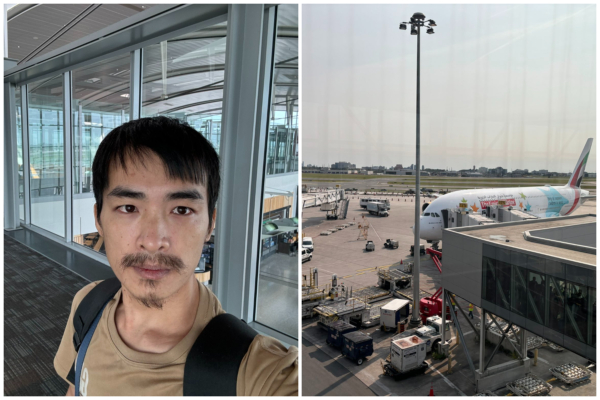During the COVID-19 lockdown in 2022, Zhengzhou, Henan Province, witnessed a mass exodus of Foxconn workers, shocking the world. Chinese dissidents alleged that their relatives working at Foxconn witnessed employees’ “bodies” being thrown into a garbage heap, prompting them to join the exodus.
In October of this year, Chinese dissident Fu Yifeng was rescued from Southeast Asia and brought to Canada. During a recent interview with NTD, he stated that the Chinese Communist Party (CCP) fundamentally does not value human life. Due to the lockdown and medical shortages, Foxconn’s factory was in a state of chaos. The region lacked order and resources, with the situation evolving through several stages.
Initially, when the pandemic broke out, there were some medical resources available, preventing a severe humanitarian disaster. However, as the mid-term approached, there was a shortage of medical resources, strict lockdown measures, and employees began fleeing. Fu Yifeng’s relatives also joined the exodus during this period. Later on, Foxconn recruited new employees, leading to serious events such as intense clashes between Foxconn workers and the police.
Social media platforms circulated videos showing employees climbing over the wire fences of Foxconn’s industrial park. Some employees with their belongings walked along the highway, taking brief rests in overgrown wastelands. Some confronted CCP police attempting to intercept them. A fortunate group managed to hitch a ride back home, but according to reports, some truck drivers who helped them were subsequently quarantined.
BBC Beijing correspondent Stephen McDonell’s Twitter posts revealed that some Foxconn employees secretly ran away, walking over a hundred kilometers back to their hometowns. Parts of Zhengzhou implemented new lockdown measures restricting movement and only allowing cars on the road once a week.
Stephen warned that if the “zero-COVID policy” continues in China, more chaotic events may occur. The public’s high level of ignorance about the virus places a significant responsibility on the government. The fear, panic, rumors, paranoia, and ignorance fueled by the “zero-COVID policy” led to the Foxconn exodus.
Japanese veteran journalist Akihio Yaita posted on Facebook on October 30, reporting that within two weeks of a COVID-19 outbreak at Foxconn, Zhengzhou authorities sealed off the factory, confining tens of thousands of employees in dormitories with no room for activities, severe shortages of food and drinking water, and masks distributed once every three days. Some employees fell ill but received no medical treatment. Eventually, some employees broke through security, initiating the mass exodus.
China News Weekly also reported on the Foxconn exodus, acknowledging that during peak periods, the Foxconn Zhengzhou Aero Park factory had over 300,000 employees, with the current number around 200,000. This implies that around 100,000 workers left, many due to economic pressure.
In the early hours of October 30, Secretary of the Party Committee at Foxconn Zhengzhou Science Park, Su Dongxia, posted on social media, emphasizing the challenges faced by managing over 200,000 people in the factory amidst the pandemic. She mentioned the internal efforts to allocate resources but limited external support, leading to a situation where employees were allowed to return home on their own. However, she later clarified that this information was a repost and not her original content.
There is a widespread belief that severe mismanagement during the pandemic led to the massive exodus of workers. But just how chaotic was the situation really?
“In reality, it was even more severe than what was reported online,” stated Fu Yifeng. He recounted horrifying scenes of employees with high fevers left untreated, some ending up dead and disposed of like garbage in trash bags, discarded into a heap. His relatives sent him videos showing bodies piled up in the factory’s backyard, the exact number unknown but at least a dozen corpses were visible.
“Many people with high fevers had impaired consciousness and were packed in garbage bags. Some even rolled out of the trash heaps,” Fu Yifeng emphasized the inhumane treatment by the authorities.
“During the chaos, my relatives, after work, decided to join the mass exodus, walking for five to six days along highways back home with others,” Fu Yifeng revealed. Upon returning home, his relative refrained from leaving, fearing repercussions from the CCP.
Fu Yifeng could not settle anywhere in China due to his lack of identification. During the pandemic, he rode his motorcycle across cities in search of jobs. At border checkpoints between counties or provinces, authorities often harassed him, demanding identification and subjecting him to COVID-19 tests.
“This disaster had no end in sight,” Fu Yifeng lamented the ongoing tragedy unfolding around them.
The Foxconn management repeatedly denied severe infections at the Zhengzhou plant. However, Chinese media reports on the Foxconn worker strikes and mass exodus have been almost entirely scrubbed from online platforms.
Nevertheless, videos and reports continue to emerge online, depicting late-night gatherings of people in hazmat suits within the Foxconn compound. One distressed woman was heard shouting, “726 rooms, all dead! It’s horrible!” The entire employee dormitory area was illuminated as workers shouted and whistled.
On November 5, a video circulated online showing a woman from Henan with a distinct accent clinging to an air conditioning unit outside a building window, demanding officials conduct nucleic acid tests or else she threatened to draw attention to the situation. She shouted, “Foxconn employees’ bodies were directly thrown away, treated as garbage!”
More footage showed individuals being dragged away in trash heaps, with uncertainty surrounding their status, while a person inside a garbage bag appeared to be moving – scenes that were described as extremely disturbing.
Some netizens suggested starvation as the likely cause of death, as one person with firsthand experience with COVID-19 attested that the virus often wasn’t lethal. They recalled previous tragedies in China where deceased bodies were treated disrespectfully.
Fu Yifeng concluded by reflecting on the ongoing perils, emphasizing the harrowing experiences he and others endured, offering a glimpse into the ongoing humanitarian crisis that seemed unending.

